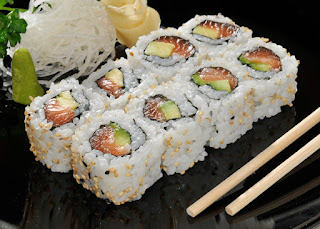Are you new to sushi? Have you ever wanted to try it
but weren’t sure where to start or what you might like? Or have you tried it
and weren’t sure if you liked it? This guide will offer some information about
how to start enjoying sushi if you’re a beginner.
Sushi isn’t wine.
You don’t have to swirl it around in a glass, and lift it up to the
light so you can see if it has any "legs".
Sushi isn’t tea. You don't have to sip it with your
little pinky lifted up in the air like the British do when they drink their cup
o’.
So, what is Sushi? A quick answer is "Anything
that is served with Sushi Rice". Which would automatically exclude Sashimi
(basically, just the slice of meat). And that is a major point of confusion for
some, even those who eat sushi often.
The
Difference between Sushi and Sashimi
Many people use the terms "Sushi" and
"Sashimi" interchangeably, but they’re actually two totally distinct
and separate items.
Let's take Sashimi first, since it’s easier to
define what sushi is once we understand sashimi clearly. The word sashimi means
"pierced body", where sashi = “pierced, stuck” and mi = “body, meat”.
In English, it’s often used to refer to uncooked fish preparations.
Generally, Sashimi can be defined as a piece of
meat, not necessarily seafood and not necessarily raw, typically draped over a
garnish like daikon (Asian white radish shredded into long strands) and
possibly accompanied by one Perilla leaf per slice. Sashimi is normally served
with a dipping sauce, like soy sauce, with wasabi paste or ponzu sauce (a
citrus based sauce made by mixing soy sauce, lemon juice, rice vinegar, dashi,
and mirin).
Some common meats served as Sashimi include:
Salmon (Sake)
Squid (Ika)
Shrimp (Ebi)
Tuna (Maguro)
Mackerel (Saba)
Horse Mackerel (Aji)
Octopus (Tako)
Whale Meat (Gei-niku)
Sea Urchin (Uni)
Scallop (Hotate-gai)
Puffer Fish (Fugu)
Yellowtail (Hamachi)
Fatty Tuna (Otoro)
Not
Everything Called Sashimi is Raw
While octopus (a popular Sashimi item in Japan), can
be found and served raw it’s normally served boiled because of its chewy
nature. And Tataki is a Sashimi that is
quickly and lightly seared on the outside, in effect cooking the outside of it,
while still leaving the inside raw. It’s then briefly marinated in vinegar,
thinly sliced and seasoned with ginger which is ground or pounded into a paste.
So while the majority of Sashimi items are served entirely raw, there are a few
that are not.
There is a Chicken Sashimi called Toriwasa, which is
considered a delicacy by some in Japan, and also a Horse Sashimi called
Basashi.
Got a firm grasp on what Sashimi is now? Clear as mud? If not, just
think meat with no Sushi Rice.
So, what is Sushi then? We’re glad you asked, Grasshopper. Sushi is any dish
that is made with vinegar sushi rice.
The
Different Types of Sushi
Maki
Sushi
Makizushi means "rolled sushi". Generally,
it’s wrapped in Nori (seaweed), but can occasionally be wrapped in a thin omelet,
soy paper, cucumber, or shiso (perilla) leaves. There are many variations of
Maki Sushi or sushi rolls. But overall, Maki Sushi comes in five different types:
Hosomaki ("thin roll" - rice on inside,
nori on the outside)
Chumaki
("medium roll" - rice on inside, nori on the outside)
Futomaki
("thick roll" - rice on inside, nori on the outside)
Uramaki
("inside-out roll" - rice on outside, nori on the inside)
Temaki
("hand roll" - cone-shaped roll)
Nigiri Sushi
Nigirizushi, meaning "hand-pressed sushi",
is typically made of a hand formed rectangle of sushi rice with a swipe of
wasabi on top, finished with some type of topping or Neta (normally Salmon,
Tuna, or other seafood).
Chirashi Sushi
Chirashizushi means "scattered sushi".
Chirashi is a type of Sushi served in a bowl with sushi rice and covered with
various toppings called "gu". The number of toppings varies, but nine
seems to be a common number. It is popular in Japanese homes because it is
simple to make and there is no one set recipe for it, making it ideal for using
up leftovers. And surprisingly, the most common types of Chirashi consumed in
Japan are actually made with no fish.
Inari Sushi
Inarizushi is a pouch of fried tofu (aburaage)
filled with Sushi Rice. The aburaage is produced by cutting tofu into thin
slices and deep frying. It can be purchased already prepared for Inari Sushi,
or you can cook it yourself using a recipe (http://www.japanesecooking101.com/inarizushi-inari-sushi-recipe/).
Cooking it yourself will allow you to adjust the sweetness to your liking.
Oshi Sushi
Oshizushi means "pressed sushi". It’s also
known as hako-sushi which means "box sushi". A wooden mold, called an
oshibako, is used to make this type. The bottom of the oshibako is lined with a
topping which is covered with sushi rice and then the lid of the mold is
pressed down to create a firm, rectangular box. It’s then cut into squares or
rectangles before serving.
Everyone has different tastes and there is
definitely no single way to approach sushi if you’re new to it. Always stay at
your comfort level and don’t be afraid to not
eat something that doesn’t appeal to you. Find your own pace and you never
know, sushi may grow on you. You may not turn into a sushi fiend, but there is
a lot to appreciate about sushi and Japanese food in general. Try what you
think that you’ll like and that looks interesting. Have a little sake and
relax.










No comments:
Post a Comment